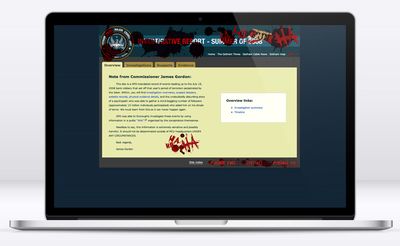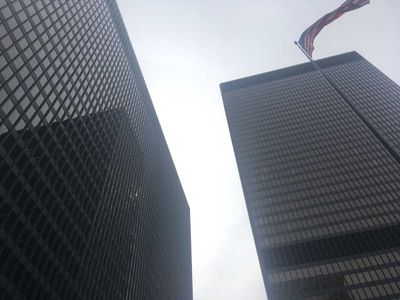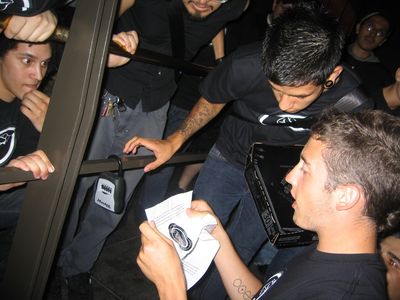On The Dark Knight, IA Summit, and designing communities we want

10 years ago today, a Batman movie was released. Normally that’s nothing to celebrate, so I’m amused to see 10-year retrospectives of The Dark Knight across multiple entertainment news sites. There are already articles about how the film changed moviemaking and geek culture forever, for good and/or bad.
For the entertainment industry, The Dark Knight’s impact is measured one way. For me personally, its impact means something quite different.
This 10-year anniversary was an unmissable opportunity for me to reminisce about the experiences I discovered and the inspiring people I met. And to take stock of my journey across the last decade – learning how to design experiences, and more recently, how to design the communities we want to be part of. And lastly, what it means to truly make a difference.
All of this began out of my experience around this one film, one that inspires me even today.
I am very much not joking when I tell people that The Dark Knight changed my life.
“Let’s wind the clocks back…”
10 years ago, I was in a completely different place.
I was 2 years into a technician job at a cancer research lab, and I still had no idea what I wanted to do with my life. For most lab techs 2 years in, they’re applying for grad school or med school. Taking that next big step in their career. But all I knew was, I didn’t want to do either! More STEM school would mean more rounds of self-flagellation. (One round in college was enough for me, thank you very much!)
But I liked doing bench work (a.k.a. the stuff you see on CSI), and I really liked the people I worked with. So I stayed. Going through the motions, more or less.
Going down the rabbit hole
And then I got pulled into an intriguing online puzzle. I’d been vaguely aware of a viral marketing campaign for the then-upcoming Batman movie, but I hadn’t been that interested before. Most of it, up to that point, had been unskilled exercises in showing up at a certain place. The first person to do it would get all the glory. For someone who worked a full-time job, count me out, right?
But this exercise was different. It was a puzzle that depended upon arcane knowledge of the campaign’s history. And it was online. There wasn’t one winner, just a group effort in online fan forums to solve the puzzle.
To contribute, I could look things up online. It turns out that looking up details of previous campaigns took a lot more effort than people (other than me, apparently) were willing to expend. So I started researching. And researching even more. And documenting, on an existing wiki. And aiming newbies toward the wiki so we wouldn’t be having the same discussion over and over again. Making sense of things.
And the moment we solved the puzzle through our collective efforts hours later, I was hooked.
For the next year and a half, I became the resident expert of this game. For one, I learned the whole shebang was called an “Alternate Reality Game,” or ARG.
I observed how the games and story pieces were designed to promote collaboration. I noted how the game designers nudged us down the right paths without direct interference.
A tight-knit community formed to support the continuous puzzle-solving effort. This was pre-GamerGate and even pre-Twitter, which I consider to be innocent times now. (I probably don’t have to mention that the vast majority of this community consisted of young men. They always had my back.)
We were just glad to have fun together, being involved in this strange, engrossing story.
Discovering design
After it was all over (I’m talking maybe 5 IMAX viewings total), I wasn’t done. I still wanted to acknowledge the experience that tight-knit community had, the magic that we felt for more than a year.
I decided to make an online archive. I didn’t know the first thing about making a website then, but I didn’t let that stop me. I took it upon myself to learn.
First, I learned about organizing content, because I knew I’d be handling a lot of it. I learned what that was called – information architecture. I made a content inventory and link map in Excel that consisted of 975 rows.
I learned about user experience design, and about creating personas to represent my audience. I learned about using discrete pieces of content to tell a story. I used Powerpoint to create my first wireframes. I wrote a lot.
I learned about HTML, CSS, Javascript, and JQuery. I learned about getting hosting and a domain. And I made my website, hand-coding all 475(ish) pages.

After about a year of work and loving almost every single second (aside for some snags with JQuery), I thought, “Hey if I did this all myself for this long and still like it, I should do it for a job!”
10 years, several design certificate programs, some hard years freelancing, and a few lucky breaks later, I’m here.
I now help make sense of San Francisco’s affordable housing program for almost a million residents. Starting next month, I will extend that impact out to all of San Francisco’s services.
I have been involved in some of the most visible user experience and information architecture communities in the world, working with designers I’ve looked up to for years. Some of these designers I now call friends.
Every day, I still reel at what I get to do.
Coming “home” to Chicago
This year, in March, the IA Summit conference was in Chicago, where most of The Dark Knight was filmed on location. I happened to be on the 2018 organizing committee, acting as content strategist/front-end developer for the website, as well as over-excited social media maven.
It was my first time in Chicago, but it also felt like coming home. This is where it all started for me, 10 years ago with a Batman movie.
Now I was working with some of my heroes, and becoming inspired and recharged by them in the magical 5 days that IA Summit always was.

That could have been the end of it. This part of my story, circling around in a nice retrospective bow. As reality usually works, this story’s not close to done.
“You either die a hero, or you live long enough to see yourself become the villain”
There were rumblings after IA Summit, about the community being unsafe, despite its initially welcoming nature. About the code of conduct being nothing more than some words on a webpage, because the culture allowed for known bad actors to participate year after year. That they would still be around next March, when the event would switch hands and become the Information Architecture Conference.
It came to a head on July 9, when the conference’s governing body released a (now-removed) legalese-heavy CYA Grievance Procedure for Code of Conduct violations. The way that it was released sent a clear message of bulldozing any concern for people who might want to file a report, in favor of reducing liability for the conference.
Twitter exploded. A number of very visible speakers and volunteers resigned over a culture that protected the careers of bad actors over the safety of attendees. (In general, it was not a good week for Codes of Conduct at design conferences.)
In the aftermath, I was mostly disappointed when I realized how many leaders in this empathy-focused industry were cowardly, refusing to take a stand on what kind of community they wanted to build. Going on as if nothing was wrong, when there was a “missing stair” in our midst that the people in charge refused to talk about.
At the same time, I acknowledge that when this happens, most people aren’t out to hurt others or make others feel unsafe.
“I believe in Harvey Dent”
We all have our own mental models for how the world works. We’ve meticulously created an architecture of beliefs that govern our reality.
How we approach social interactions, how we think about success, how we think about our own potential. Each one is a window into our perception of how the world works.

“This is what happens when an unstoppable force meets an immovable object”
When we hang our beliefs on something, we will attempt to rewrite our own realities to make it true. Even if it isn’t.
Any cognitive dissonance and defensive behavior results in a backfire effect, where you hang onto beliefs even more. Even if they’re wrong.
The harder someone pushes, the more we push back. Sometimes until we become the very people we vowed we wouldn’t be.
“Does it depress you….to know just how alone you really are?”
Working against a backfire effect, especially on a societal level, can feel insurmountable.
How can we fix a system that just accepts a level of harm, that allows for various systemic –isms to go unchecked, that promotes vicious competition over healthy collaboration?
“They’re only as good as the world allows them to be”
We can design around it. It’s possible. Our mental models are affected by what we perceive as incentives and goals inherent in the system.
To combat the backfire effect, we can’t just burn everything down. We have to replace it with something better. We have to rewrite people’s mental models.
That makes it possible to expect collaborative behavior out of everyone. To make a system that doesn’t require that one extraordinary person take a stand against the entire world.
“Batman could be anybody”
We don’t need our heroes to come around. In fact, it’s better not to depend on our heroes saving us at all. We can’t wait for them.
We can design our own incentives to make it work for us. We can design around the behaviors we predict, to create the kind of world we want to see.
Take the ARG that started this whole journey. When coming up with a new activity, the foremost thought on the game designers’ minds was player safety. They had to predict the extremes of what players might do in their excitement, and create the activities accordingly.
Granted, there will always be hiccups and unforeseen crowding in planning something unprecedented like a Joker-themed scavenger hunt at San Diego Comic Con. But in general, the real-life events clearly leaned toward fun and collaboration, not dog-eat-dog competition. That’s by design.

“The night is darkest just before the dawn”
I believe we can do it. When creating a new community culture, we may not know what’s on the other side. We may only have a set of principles to guide our way. But that’s part of the beauty – by working with what we have, we can come up with something even better than we could imagine.
As a designer now, I see the potential of our collective impact more than ever. Ideally, we would design a world where someone like Batman wouldn’t even be needed.
While I embark on helping to build up the Information Architecture Conference and San Francisco Digital Services, I’ll take the following with me:
- Don’t be the one hero. Forge alliances. Find a tribe that also believes we can make things better. I’m optimistic that we have the right team behind IAC and SF Digital Services to make this happen.
- Learn from each other. Encourage each other. We can only make the most impact if we put our brains together and combine our expertise. Take a look at analogous areas and see what they’re doing. Maybe you can take something from that.
- Meet people where they are. Don’t forget that we are all human, and all personally struggling with different things.
- Design the narratives for where we all want to go. Decide what the incentives should be. We have to plan ahead in order to secure the futures we want.
“…Not a hero…a silent guardian, a watchful protector, a dark knight”
So, how come people are still talking about a movie that came out 10 years ago? Many will talk about its elevation of superhero movies, the political relevance, and Heath Ledger’s Oscar-winning performance.
For me, The Dark Knight’s legacy hinges on its last 2 minutes and what it inspires in me.
Batman and his allies have been beaten and battered, their ideals utterly broken over the course of only a few days. But they still believe that a better world is possible.
Batman believes in that possibility so much, that he sacrifices his own legacy to see it through.
We need some of that unflagging optimism now. To face a broken system, a system that has failed us multiple times, and say, “We can make this better.”
Using a lie isn’t the best way of going about this; it obviously isn’t sustainable. I love you Batman, but no need to be so dramatic!
But we can forge alliances, combine our strengths, listen to people, and design narratives to lead people in the right direction. We can make a better world, no heroes required.
Let’s get started.
